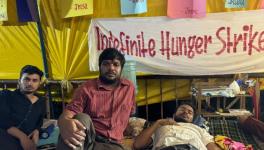Health Insurance: The Road to Health for All?
In 2007 the Government of Andhra Pradesh launched an insurance scheme that was designed to protect patients from the ‘catastrophic’ impact of out of pocket expenses incurred on hospital care.
Arogyasri’s apparent utility was quickly picked up by the Central Government and a nationwide scheme modeled on Arogyasri was launched in 2009 – called the Rashtriya Swasthya Bima Yojana (RSBY). In the UPA-II’s rather bare cupboard of programmes for social welfare, the RSBY scheme has been held out as a major achievement.
Similar state level schemes have also been launched or are in the process of being launched in Kerala, Tamil Nadu (originally called the Kalaignar Scheme, since renamed by the new state government), Delhi (Apka Swasthya Bima Yojana), Karnataka and Maharashtra (Rajiv Gandhi Jeevandayee Arogya Yojana). The roll out of these schemes have been impressive – by the end of 2010 an estimated 247 million people (25% of the country’s population) were covered by one or more of these schemes. Coverage has, since, expanded even further. This is a huge jump from the pre-2007 situation when the two social insurance schemes in existence were the Employees State Insurance Scheme (ESIS) launched in 1952 and the Central Government Health Scheme (CGHS) launched in 1954. The former covers employees in the organised sector (about 7 percent of the country’s work force) while the latter covers employees working for the government. Both are funded through co-payments made by employees and employer.
As plans are now being readied to launch the present government’s vision of a reformed health system, through the lens of the Twelfth Five Year Plan, insurance schemes such as the RSBY are poised to get even larger attention and support. It thus becomes necessary to critically assess the underlying elements of these insurance schemes. Particularly so as it is being claimed that these initiatives will protect people from the impact of catastrophic expenses on medical care, because of which an estimated 6 crore people are driven below the poverty line every year.
Content of the Health Insurance Schemes
Let us step back to understand the content of these schemes and their underpinning logic. All these schemes are meant for hospital care only. All of them have a list of procedures which are covered – which means that reimbursements are limited to this list. A fundamental innovation that has been introduced in these insurance schemes is that patients are provided a ‘choice’ of accredited institutions where they can receive treatment. These institutions can be in the public or the private sector. Like any insurance package these schemes have a ceiling for reimbursement. This ceiling varies – it is set at Rs.30,000 per family of five in the RSBY schemes, while some state schemes such as the Arogyasri reimburse up to Rs.1,50,000 or more. While the RSBY scheme started off by being restricted to BPL families, many state schemes now cover non-BPL families as well. All these schemes are publicly funded – i.e. the annual premiums for beneficiary families are paid by the Government. In the case of the RSBY scheme the central the cost of the premiums is shared by the Centre (75%) and state (25%). The state schemes are funded by the state budgets.
A fair question to ask is, given the outline of the insurance schemes like RSBY, shouldn’t such schemes be supported? After all they are paid for entirely by the government and they reimburse expenses incurred – often very steep – to access care that involves hospitalization. The schemes have the added advantage of being cashless, i.e. payments are made directly to the provider and the patients do not have to pay themselves. The RSBY has also introduced ‘portability’, i.e. those registered in one place can avail of the scheme when they move to another location.
To arrive at a reasoned answer to this question we need to examine this scheme in the context of the entire health system. There are two fundamental pillars of insurance schemes of this kind. First, they operate on the logic of what is called ‘spilt between financing and provisioning’. What this means is that there is a clear separation between the financing of services provided, and the facilities where these services are provided. Thus, in the case of all these schemes, while the financing is through public resources (central or state government funds) the treatment can be provided by any accredited facility. Such facilities can be either public (i.e. government hospitals) or private. In practice, a large majority of accredited institutions are in the private sector. The second pillar of all these insurance schemes is that beneficiaries are insured against a set of ailments that require hospitalization (unlike the old ESIS and CGHS schemes which are supposed to cover all forms of care). So beneficiaries are not guaranteed care for all ailments – in other words it is not a promise to provide comprehensive health care, but to provide care for a pre-defined package of procedures.
These basic tenets of the insurance schemes have to be understood in the context of the country’s health system. The public system is under resourced and access to it is difficult for a very large number of patients. Over 70% of health care costs are borne by patients themselves as they are forced to look for care in the private sector. The private sector is almost entirely unregulated and is a mix that ranges from primarily unqualified practitioners in rural areas, charitable institutions, small private nursing homes and hospitals, and large chains of corporate hospitals. Over the past decade there has been a huge expansion in the last category – of chains of corporate hospitals. These have expanded to fill in the void left by an inadequate public system and operate almost entirely in towns and cities. The public system still caters to almost 60% of hospitalized patients, while almost 90% of out-patient care is accessed through the private sector. Thus, a majority of expenses incurred by patients is in out-patient care.
Impact on the Health System
Let us now examine the effect that the insurance schemes have on the existing health system. The split between financing and provisioning explicitly opens the door for participation by the private sector. In most situation a large majority of accredited providers are in the private sector. Supporters of insurance argue that it shouldn’t matter where people get medical care, as long as they are assured good care. They also argue that ‘competition’ between different providers will improve the quality of care. Unfortunately evidence available suggests something totally different.
A recent analysis of the Arogyasri scheme in the Economic and Political Weekly (N.Purendra Prasad, P.Raghavendra, Healthcare Models in the Era of Medical Neo-liberalism: A Study of Aarogyasri in Andhra Pradesh, Economic and Political Weekly, October 27, 2012) provides very interesting data. The analysis notes that “The Aarogyasri Trust has empanelled 491 hospitals in the state, of which nearly 80% are in the private sector while the remaining 20% are government hospitals. Although the Aarogyasri scheme is meant for poor villagers, there is not even one private hospital in the rural areas, while the distribution of empanelled government hospitals in rural and urban areas is almost even”. The financing provider split is a mechanism that has been the hallmark of health sector reforms in many parts of the world and is part of the neoliberal framework. In such a framework patients become ‘consumers’ and are provided with a ‘choice’.
Competition and False Choice
Unfortunately the choice provided by such a model is a false choice. For people to exercise their choice information is crucial. In the case of medical care patients, especially poor and vulnerable patients, have little or no information. Patients (now called consumers!) are ideal candidates for being enticed by the private sector, especially the well resourced corporate hospital chains. They are enticed by fraudulent claims hidden in the garb of technical jargon. In the past few months there have been several stories in the media regarding the sharp rise in hysterectomies (operations involving removal of the uterus) since the introduction of the RSBY scheme.
In Chhattisgarh, the director of health services, under public pressure, appointed a fact-finding team and suspended doctors involved in 22 cases, where it could be proved that the operations for hysterectomy were conducted without medical reasons. Dainik Bhaskar reported that just one private hospital (Gupta Hospital in Dhamtari) conducted 604 hysterectomies in 900 days. In comparison, the government-run Ambedkar Hospital in Raipur conducted just seven such operations in the same period. Other media reports indicated that In Bihar an estimated 16,000 hysterectomies, most of them deemed unnecessary, have been conducted. Everybody in the know acknowledges that these reports are just the tip of the iceberg. Unethical practices have become the cornerstone of the RSBY scheme in many parts of the country – leading to unnecessary investigations, medication and surgeries that only help the profit hungry providers.
The EPW analysis reports how ‘Arogyamitras’ are appointed by private hospitals to scout around for patients who can be enticed to get operated upon in private hospitals. The private hospitals also ‘cherry pick’, i.e. they pick and choose those patients that provide the highest returns and refer others to government hospitals. The refuse patients who are likely to have poor outcomes or are not likely to provide good returns. Government facilities are not structured to compete in the ‘market’ for health care, and gain little even if they are empanelled. This is thus the kind of choice that the poor and vulnerable are provided – a choice based on false motivations and enticements by profit hungry private hospitals.
Limited Package and Skewed Priorities
We now turn to the other pillar of the insurance model – only a pre-approved package of procedures are covered, and only applicable if they require hospitalization. This leaves out not just important conditions that require hospitalization, but the entire range of ailments that are treated through out-patient care. There is clear evidence that the major burden of diseases lie outside the packages covered by the insurance schemes. These include almost all infectious diseases that are treated in out-patient settings – including those that require prolonged treatment such as tuberculosis. Most chronic diseases like diabetes, hypertension and heart diseases also get left out of the package. A cancer patient who needs to take expensive treatment for months would not be included unless hospitalized! Rough calculations indicate that the packages cover 2-3% of the actual burden of disease that exists in a community.
Such skewed priorities end up by distorting the existing health system. In AP the Arogyasri scheme draws 25% of the state’s health budget while covering for 2% of the burden of disease. Insurance schemes, thus, draw away resources from the already resource-starved public health system and fattens the coffers of corporate hospitals. In other words public money is being squandered to strengthen the already dominant corporate private health sector. The same resources, if used to strengthen the public health system, would leave the nation with assets that are under public control and can be used for public good. A study done by the Public Health Resource Network (PHRN) and the Centre for Social Medicine and Community Health (CSMCH), JNU, in Chhattisgarh showed that the revenues of Govt. institutions empanelled under RSBY have not increased, while at the same time previously available maintenance funds have been withdrawn.
Importantly, perhaps the worst harm that such insurance schemes cause is to distort the entire structure of the health system. Good health systems are like pyramids – the largest numbers can be treated at the primary level where people live and work, some of these need to be referred to a higher level of care (secondary level like community health centres), and a few would need specialized care in specialty hospitals (the tertiary level). That is why it makes sense to spend more attention and resources to the primary level. Such an approach is more scientifically valid and efficient. Better primary and secondary level care ensures that fewer patients will need to seek care in specialty hospitals and undergo extensive procedures. An insurance system that sits on top of the health system overturns the pyramid and starves the primary care facilities. In 2009–10, direct government expenditure on tertiary care was a little over 20 per cent of total expenditure. However, if this were added to the expenditure on the insurance schemes that focus entirely on hospital based care, the total public expenditure on tertiary care would be about 37 per cent of the total expenditure.
There are other major deficits in the structure of the insurance schemes. Enrolment is patchy and the claims of being cashless and portable are not universally true. The PHRN-CSMCH study in Chhattisgarh shows that enrolment among entitled beneficiaries continues to be low (30 to 50 %) and no enrolment has been done in remote and inaccessible villages. It also showed that claims could take 6 months to 2 years to be settled in some cases.
Conclusion
The health insurance model was introduced to protect people from the catastrophic impact of health care expenditure, especially among the poor and the vulnerable. While such benefits would have accrued to a small number of beneficiaries genuinely requiring hospital care, by and large the schemes are inimical to the development and sustenance of a robust public health system. The Ministry of labour, which administers the RSBY scheme, would like to promote the scheme as pro-worker and pro-poor. This is a gross travesty of the actual situation. The only guarantor of secure access to quality health care is a well resourced and accountable public health system.
The working of the insurance schemes should be comprehensively enquired into, especially the very serious charges against private hospitals that they are attempting to ‘milk’ the scheme by resorting to a range of unethical practices. The working people of this country deserve much better, and trade unions and peoples organisations need to be involved in a thorough scrutiny of the RSBY and other like schemes.
Get the latest reports & analysis with people's perspective on Protests, movements & deep analytical videos, discussions of the current affairs in your Telegram app. Subscribe to NewsClick's Telegram channel & get Real-Time updates on stories, as they get published on our website.
























